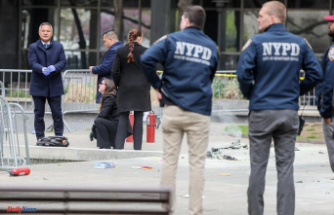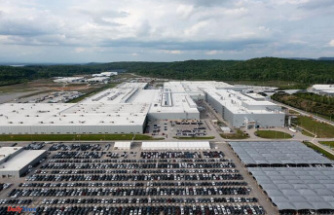Conrad Cutler drives a Porsche Macan, which seems fitting considering the 26-year-old entrepreneur has made his money one can—and bottle—at a time.
Less than five years out of college, Cutler runs Galvanize Group, a four-year-old business that generates almost $10 million in annual revenue from collecting recyclable cans and bottles around the city and returning them to the distributors, who pay the 5-cent deposit plus a state-mandated 3.5-cent handling fee for each one. In the winter about 1 million empty containers of Coke, Poland Spring and other beverages consumed in the city are sorted weekly by about 35 full-time employees at his Mount Vernon warehouse. Volume doubles during the warmer months, when New Yorkers tend to consume more cold drinks, so he keeps his shop open 24 hours in the summer.
“My friends make fun of me, saying I go through people’s garbage for a living,” said Cutler, whose company processes about 110 million empty bottles and cans every year.
article continues below advertisement “One part of the government encourages redeeming recyclables; another part discourages it. And we’re caught in the middle.”Cutler’s pals may mock him, but to city officials, his bustling business is no laughing matter. In their eyes he and the collectors who supply him are undermining the municipal recycling program by seizing the most valuable items before the city can pick them up and resell them as a commodity. Metal, glass and plastic collected by sanitation department crews are routed to a private company called Sims Municipal Recycling, which has a multiyear agreement with the city to process recyclables at a Brooklyn facility.
In a trade publication in 2012, Robert Lange, a former head of the city’s Bureau of Waste Prevention, Reuse and Recycling, labeled outfits like Cutler’s a “sophisticated mob of scavenger collectives that systemically removes valuable recyclables…and leaves the worthless and costly-to-collect rest for the Department of Sanitation.”
A less harsh critic, Wayne DeFeo, an industry expert and founder of consulting firm DeFeo Associates, said Cutler operates in an “ethical gray zone.”
The controversy rests on how Cutler goes about gathering his millions of bottles and cans. Some come from large retail outlets, such as CVS stores. Most, however, are sourced via a network of 100 subcontractors who have relationships with apartment supers and property managers and give Cutler’s crews first dibs on recyclables before they’re hauled to the curb. (It’s illegal to rummage through recyclables once they’re curbside, but it’s impossible for Cutler to police that.)
Photo: Buck Ennis DIGGING FOR ALUMINUM: Cutler gets cans and bottles from a network of 100 subcontractors. It's illegal to grab recyclables from the curb, though Cutler can't police his whole supply chain.Bars and restaurants are less important sources, as those establishments seldom generate more than a few hundred empties per day. The largest volume comes from office buildings.
“A big tower will have thousands of people working in it and consuming two or three bottled beverages every day,” said Cutler, adding that a dedicated collector can bank up to $200 a day, which translates to 4,000 bottles or cans daily.
Plus, Cutler said, his firm helps make the city cleaner by picking up recyclables that might otherwise litter the streets. Such litter remains common even though the state has imposed a refundable nickel deposit on every bottle and can of soda or beer since 1982. (Plastic noncarbonated beverage bottles were added to the mix eight years ago.)
But according to the state Department of Environmental Conservation, deposits went uncollected on 34% of returnables, or about 2 billion containers, last year. That return rate has held steady over time, and Cutler said both the state and beverage distributors have a vested interest in keeping it down. To understand why, it helps to know how New York’s recycling economy works.
Going with the flow
Retailers pay a 5-cent deposit on every beverage they buy from distributors such as Coca-Cola, Nestlé and Manhattan Beer
Distributors, then pass the cost along to consumers. If a consumer—or a collector—fails to redeem the bottle or can, the distributor gets to keep one penny of the deposit and sends the state 4 cents. Multiply those cents by billions of containers and you’re talking about real money. Unredeemed deposits result in more than $100 million in revenue every year for the state, according to DEC data, for a total of $770 million since 2009. About $20 million of that money annually goes to support environmental protection programs, with the balance flowing to the general fund.
Redemption story RETAILERS, such as supermarkets or bodegas, buy beverages and pay the distributor a state-mandated 5-cent deposit per container.CONSUMERS buy the drinks and on top of the purchase price pay 5 cents per container. The consumer either returns the empties to redeem the deposit or tosses them in a garbage can or recycling bin, where they are picked up by city sanitation crews or by enterprising scavengers.
SANITATION workers send bottles and cans to Sims Municipal Recycling, which has a contract to process recyclables and share the revenue with the city. Scavengers take their wares to someone like Conrad Cutler, who pays them the 5-cent deposit per container.
CUTLER then calls a beverage distributor, such as Coca-Cola, Nestlé or Manhattan Beer Distributors, to pick up its bottles or cans at his warehouse. By law distributors must pay Cutler the 5 cents plus another 3.5 cents per item to help cover his overhead.
WHEN BOTTLES and cans aren’t redeemed, distributors get to keep 20% of the deposit and return the other 80% to the state. New York makes about $100 million in revenue annually from unredeemed bottles and cans. About $20 million goes to environmental programs and the rest to the general fund.
This complex ecosystem means that although recycling keeps streets clean and helps the environment, when people don’t redeem their bottles and cans, there is a financial benefit for the state.
“One part of the government encourages redeeming recyclables; another part discourages it,” Cutler said. “And we’re caught in the middle.”
A logistics major at Syracuse University, Cutler recognized the opportunity in recycling after observing how many beverages his fraternity brothers were consuming. He launched Galvanize Group four years ago and said he has funded operations with his own money. (He also owns a laundry service.)
His warehouse is constantly abuzz with trucks making drop-offs or pickups, as staffers furiously sort containers based on which distributor handles the brand. Some employees are deaf or hearing-impaired, so they aren’t bothered by the din.
Cutler’s is one of about 30 area companies—known as redemption centers—where scavengers unload the bottles and cans they’ve picked up off the streets or from garbage cans. Those redemption centers got a big boost in 2009, when Albany adopted a law called the Bigger Better Bottle bill. The statute was designed to improve recycling infrastructure by raising the fee consolidators like Cutler could charge distributors who pick up recyclables from 2 cents per container to 3.5 cents.
Metal urgency
But that well-meaning rate increase had the perhaps unintentional consequence of hurting the city’s recycling efforts by making it more lucrative for redemption centers to gather as many bottles and cans as they possibly can, however they can. And while redeemers like Cutler aren’t concerned about what exactly they collect, because they get paid the same for either a bottle or a can, the city cares a lot about cans because their valuable aluminum helps cover the cost of picking up less lucrative plastic and glass, considered the bane of municipal recycling.
“Aluminum is the lifeblood of any recycling program,” DeFeo said.
A report last year by the Independent Budget Office found that the city captures only 28% of recyclable cans, about half the national average. The shortfall in aluminum goes a long way toward explaining why the city’s metal, glass and plastic recycling program posted a $20 million deficit in fiscal 2016. Collecting more cans could close that gap, because the market value of an aluminum can is 2 cents, while a plastic water bottle is worth one-third of a cent, and used glass has very little value because it is expensive to handle and often comes contaminated with garbage.
Cans could become even more valuable as the price of aluminum recovers from a long slump. The commodity rose by 14% last year, the first increase since 2012, and is forecast to climb by another 9% this year, according to research firm CPM Group. “There has been a correction of the oversupply problem that weighed on prices,” said Mu Li, CPM’s director of base and specialty metals research.
As the quest for cans intensifies, so do hostilities between Cutler and government officials. He said his application to open a new processing center in the Bronx has been met with silence by the state, while sanitation inspectors frequently fine his drivers for improper collecting and have impounded his trucks seven times. The rising minimum wage also threatens to swallow his profits, so Cutler is lobbying members of the state Legislature to raise the handling fee he can charge distributors.
“Do we want to encourage recycling or not?” he asked. “We need to think about what kind of message is being sent.”
Conrad Cutler drives a Porsche Macan, which seems fitting considering the 26-year-old entrepreneur has made his money one can—and bottle—at a time.
Less than five years out of college, Cutler runs Galvanize Group, a four-year-old business that generates almost $10 million in annual revenue from collecting recyclable cans and bottles around the city and returning them to the distributors, who pay the 5-cent deposit plus a state-mandated 3.5-cent handling fee for each one. In the winter about 1 million empty containers of Coke, Poland Spring and other beverages consumed in the city are sorted weekly by about 35 full-time employees at his Mount Vernon warehouse. Volume doubles during the warmer months, when New Yorkers tend to consume more cold drinks, so he keeps his shop open 24 hours in the summer.
“My friends make fun of me, saying I go through people’s garbage for a living,” said Cutler, whose company processes about 110 million empty bottles and cans every year.
Cutler’s pals may mock him, but to city officials, his bustling business is no laughing matter. In their eyes he and the collectors who supply him are undermining the municipal recycling program by seizing the most valuable items before the city can pick them up and resell them as a commodity. Metal, glass and plastic collected by sanitation department crews are routed to a private company called Sims Municipal Recycling, which has a multiyear agreement with the city to process recyclables at a Brooklyn facility.
In a trade publication in 2012, Robert Lange, a former head of the city’s Bureau of Waste Prevention, Reuse and Recycling, labeled outfits like Cutler’s a “sophisticated mob of scavenger collectives that systemically removes valuable recyclables…and leaves the worthless and costly-to-collect rest for the Department of Sanitation.”
A less harsh critic, Wayne DeFeo, an industry expert and founder of consulting firm DeFeo Associates, said Cutler operates in an “ethical gray zone.”
The controversy rests on how Cutler goes about gathering his millions of bottles and cans. Some come from large retail outlets, such as CVS stores. Most, however, are sourced via a network of 100 subcontractors who have relationships with apartment supers and property managers and give Cutler’s crews first dibs on recyclables before they’re hauled to the curb. (It’s illegal to rummage through recyclables once they’re curbside, but it’s impossible for Cutler to police that.)
Bars and restaurants are less important sources, as those establishments seldom generate more than a few hundred empties per day. The largest volume comes from office buildings.
“A big tower will have thousands of people working in it and consuming two or three bottled beverages every day,” said Cutler, adding that a dedicated collector can bank up to $200 a day, which translates to 4,000 bottles or cans daily.
Plus, Cutler said, his firm helps make the city cleaner by picking up recyclables that might otherwise litter the streets. Such litter remains common even though the state has imposed a refundable nickel deposit on every bottle and can of soda or beer since 1982. (Plastic noncarbonated beverage bottles were added to the mix eight years ago.)
But according to the state Department of Environmental Conservation, deposits went uncollected on 34% of returnables, or about 2 billion containers, last year. That return rate has held steady over time, and Cutler said both the state and beverage distributors have a vested interest in keeping it down. To understand why, it helps to know how New York’s recycling economy works.
Going with the flow
Retailers pay a 5-cent deposit on every beverage they buy from distributors such as Coca-Cola, Nestlé and Manhattan Beer
Distributors, then pass the cost along to consumers. If a consumer—or a collector—fails to redeem the bottle or can, the distributor gets to keep one penny of the deposit and sends the state 4 cents. Multiply those cents by billions of containers and you’re talking about real money. Unredeemed deposits result in more than $100 million in revenue every year for the state, according to DEC data, for a total of $770 million since 2009. About $20 million of that money annually goes to support environmental protection programs, with the balance flowing to the general fund.
This complex ecosystem means that although recycling keeps streets clean and helps the environment, when people don’t redeem their bottles and cans, there is a financial benefit for the state.
“One part of the government encourages redeeming recyclables; another part discourages it,” Cutler said. “And we’re caught in the middle.”
A logistics major at Syracuse University, Cutler recognized the opportunity in recycling after observing how many beverages his fraternity brothers were consuming. He launched Galvanize Group four years ago and said he has funded operations with his own money. (He also owns a laundry service.)
His warehouse is constantly abuzz with trucks making drop-offs or pickups, as staffers furiously sort containers based on which distributor handles the brand. Some employees are deaf or hearing-impaired, so they aren’t bothered by the din.
Cutler’s is one of about 30 area companies—known as redemption centers—where scavengers unload the bottles and cans they’ve picked up off the streets or from garbage cans. Those redemption centers got a big boost in 2009, when Albany adopted a law called the Bigger Better Bottle bill. The statute was designed to improve recycling infrastructure by raising the fee consolidators like Cutler could charge distributors who pick up recyclables from 2 cents per container to 3.5 cents.
Metal urgency
But that well-meaning rate increase had the perhaps unintentional consequence of hurting the city’s recycling efforts by making it more lucrative for redemption centers to gather as many bottles and cans as they possibly can, however they can. And while redeemers like Cutler aren’t concerned about what exactly they collect, because they get paid the same for either a bottle or a can, the city cares a lot about cans because their valuable aluminum helps cover the cost of picking up less lucrative plastic and glass, considered the bane of municipal recycling.
“Aluminum is the lifeblood of any recycling program,” DeFeo said.
A report last year by the Independent Budget Office found that the city captures only 28% of recyclable cans, about half the national average. The shortfall in aluminum goes a long way toward explaining why the city’s metal, glass and plastic recycling program posted a $20 million deficit in fiscal 2016. Collecting more cans could close that gap, because the market value of an aluminum can is 2 cents, while a plastic water bottle is worth one-third of a cent, and used glass has very little value because it is expensive to handle and often comes contaminated with garbage.
Cans could become even more valuable as the price of aluminum recovers from a long slump. The commodity rose by 14% last year, the first increase since 2012, and is forecast to climb by another 9% this year, according to research firm CPM Group. “There has been a correction of the oversupply problem that weighed on prices,” said Mu Li, CPM’s director of base and specialty metals research.
As the quest for cans intensifies, so do hostilities between Cutler and government officials. He said his application to open a new processing center in the Bronx has been met with silence by the state, while sanitation inspectors frequently fine his drivers for improper collecting and have impounded his trucks seven times. The rising minimum wage also threatens to swallow his profits, so Cutler is lobbying members of the state Legislature to raise the handling fee he can charge distributors.
“Do we want to encourage recycling or not?” he asked. “We need to think about what kind of message is being sent.”
A version of this article appears in the February 20, 2017, print issue of Crain's New York Business as "Can do".
Sign up for our FREE weekly Small Business Alert email newsletter. An essential summary of the week's top headlines selected for small businesses.
More Newsletters ›
Our editors found this article on this site using Google and regenerated it for our readers.












